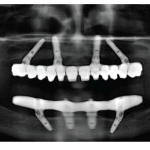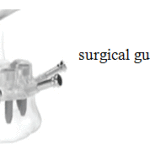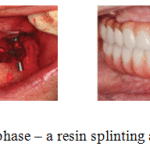Manuscript accepted on :
Published online on: 29-12-2015
Plagiarism Check: Yes
B. Anandh1, B. Lokesh2, Vijay Ebenezer3, S. Jimson4, J. Parthiban5
1B.Anandh MDS, Senior Lecturer, Department of Oral and Maxillofacial Surgery,Tagore Dental College and Hospital, Rathinamangalam, Melakottaiyur Post, Chennai – 600127 2B.Lokesh MDS, Senior Lecturer, Department of Oral and Maxillofacial Surgery,Tagore Dental College and Hospital, Rathinamangalam, Melakottaiyur Post, Chennai – 600127 3Vijay Ebenezer, Professor and Head, Department of Oral and Maxillofacial surgery, Sree Balaji Dental College, Bharath University, Pallikaranai, Chennai-600100 4S.Jimson MDS, (Research Scholar – Bharath University) Professor and Head, Department of Oral and Maxillofacial Surgery,Tagore Dental College and Hospital, Rathinamangalam, Melakottaiyur Post, Chennai – 600127 5J.PARTHIBAN, MDS, Reader, Department of Oral and Maxillofacial Surgery,Tagore Dental College and Hospital, Rathinamangalam, Melakottaiyur Post, Chennai – 600127
DOI : https://dx.doi.org/10.13005/bpj/756
Download this article as:| Copy the following to cite this article: Anandh B, Lokesh B, Ebenezer V, Jimson S, Parthiban J. J. All on Four - The Basics. Biomed Pharmacol J 2015;8(October Spl Edition) |
| Copy the following to cite this URL: Anandh B, Lokesh B, Ebenezer V, Jimson S, Parthiban J. J. All on Four - The Basics. Biomed Pharmacol J 2015;8(October Spl Edition). Available from: http://biomedpharmajournal.org/?p=3352> |
Introduction
Advances in implant dentistry have allowed a shift from the early paradigms established by the pioneer work of Branemark and his coworkers. While initial healing of 6 months in the maxilla and 3 months in the mandible was recommended, progress in the understanding of biology and technical developments have allowed immediate loading of implants in specific
clinical situations. One such situation is represented in the fully edentulous jaw.1 The All-on-4 concept is one such treatment procedure which enlightens us for its use in the completely edentulous patients, which also leaves behind the routine treatment alternative of conventional dentures with successful outcome in the short term, long term and the retrospective studies that have been done in the past2.
The concept of All on four
Alveolar atrophy in the posterior regions of fully edentulous patients often hinders with the placement of dental implants without being augmented to increase the height and width of available alveolus. The technique-sensitive augmentation surgery for the atrophied alveolus also has the potential for increased patient morbidity and complications. One suggested treatment option to avoid these unfavourable posterior areas is the use of tilted implants to allow for a better anterior-posterior spread of dental implants. This in turn favors a better load distribution. This concept, known as “All-on-Four,” was described by Paulo Malo and coworkers in 2003. In brief, four (or more) implants are placed in the anterior part of the fully edentulous jaw. The two most anterior implants are placed axially, and the posterior implants are placed in an angled position to maximize implant length and avoid anatomic structures (ie, mental nerve and anterior border of the maxillary sinus). These implants are loaded immediately with a provisional fixed dental prosthesis.1
General considerations
- To achieve primary implant stability (35 to 45 Ncm insertion torque).
- Indicated with a minimum bone width of 5mm and minimum bone height of 10mm from canine to canine in maxilla and 8mm in mandible.
- If angulation is 300 or more, the tilted implants can be splinted.
For tilted posterior implants, the distal screw access holes should be located at the occlusal face of the first molar, the second premolar, or the first premolar.
 |
Figure 1 |
Advantages of the All-on-4 concept
- Angled posterior implants avoid anatomical structures
- Angled posterior implants allow longer implants anchored in better quality bone
- Reduces posterior cantilever
- Eliminates bone grafts in the edentulous maxilla and mandible in majority of cases.
- High success rates
- Implants well-spaced, good biomechanics, easier to clean, immediate function and aesthetics
- Final restoration can be fixed or removable
- Reduced cost due to less number of implants and avoidance of grafting in the majority of cases.
Limitations
- Good general health and acceptable oral hygiene.
- Sufficient bone for 4 implants of at least 10mm in length.
- Implants attain sufficient stability for immediate function.
Disadvantages
- Free hand arbitrary surgical placement of implant is not always possible as implant placement is completely prosthetically driven.
- Length of cantilever in the prosthesis cannot be extended beyond the limit.
- It is very technique sensitive and requires elaborate pre-surgical preparation such as CAD/CAM, surgical splint.
Surgical Procedure
Implants in the maxilla are placed with two distal implants in the posterior region which are tilted anterior to the maxillary antrum while in the mandible implants are positioned anterior to the mental foramen. They should be inserted at an angulation of 300-450. The use of All-on-4 surgical guide assists in ensuring the placement of implants with correct positioning, angulation and emergence. The guide is placed into a 2mm osteotomy that is made in the midline position of the maxilla or mandible and the titanium band is contoured to follow the arc of the opposing arch. The guide also assists in retracting the tongue in mandibular cases. The vertical lines on the guide are used as a reference for drilling at the correct angulation, which should not be greater than 450.
Bevilacqua et al., demonstrated that tilting of the distal implant by 300 in a FFP decreased the level of stress by 52% and 47.6% in compact bone and cancellous bone respectively, when compared to vertical implants supporting FFP with longer cantilevers3. The use of angled abutments on two tilted implants placed in a curved arch and with cross-arch splinting might help decrease the stresses around the distal implants4.
There are three phases in All on Four concept:
- Surgical phase
- A-P spread
- Prosthetic phase
Surgical phase
Step 1 -Selection of case satisfying the inclusion criteria
Step 2-Planning implant placement using All-On-4 Guide(Prefered)
Step 3-Location of Maxillary Antrum and Mental Foramen with All-On-4 Guide
Step 4-Implant placement done following the protocols
 |
Figure 2 : Surgical guide and template |
Anterio-posterior spread
Rangert-10 mm for a cantilever of 20 mm (2xA-P-spread)for mandibular ISFPs
English-ISFPs should be 1.5 times A-P-spread for mandible maxillary ISFP posterior cantilever should be reduced to 6-8mm due low bone density
Prosthetic phase
Step 1-Open tray impression made with wire and GC resin splinting for improved accuracy
Step 2-Final impressions after integration is verified, being splinted with GC resin and metal.
Step 3-All ceramic Zirconia bridge being designed with CAD/CAM technology
Step 4-Use of CAD/CAM zirconia bridge or Titanium framework milled for crown cementation
Step 5-Crowns luted to zirconia framework
Step 6-Implant-supported zirconia bridge framework with individual crowns luted.
 |
Figure 3: prosthetic phase – a resin splinting and final prosthesis |
Loading the healing bone
The All-on-4 concept advocates immediate loading. A slight load on healing bone shortens healing time rather than prolonging 4. Immediately loaded implants osseointegrate early with adequate strength provided that the forces and implant micromotion are controlled.
Immediate extraction socket placement
The connection of implants may provide a safer transfer of load on each implant, so the placement of implants in healed or fresh extraction socket region may not influence implant survival when rehabilitating patients with totally edentulous maxilla and mandible4.
From a surgical perspective, the most notable are careful implant site preparation (including tapping), use of relatively low – torque producing implants , the preparation of an osseous shelf to level the alveolar ridge and establish optimum implant sites and the provision of adequate interocclusal space.
From a prosthetic perspective, the high success rate obtained with this protocol, including minimal bone loss even with multiple extractions and bone reduction followed by immediate function is believed to be as a result of
- Stable splinting of all four implants with the provisional immediately after surgery
- Careful occulsal adjustment to provide bilateral occulsion in the canine and first premolar areas
- Avoid occlusal contact toward the distal of the prosthesis and maximizing the anteroposterior spread.
An Anteroposterior spread that minimizes the distal cantilevers and establishes well distributed four-point stability was probably contributary to both implant and prosthetic success. The immediate implant loading and function in the dental extraction setting can be performed with a high degree of confidence.
Discussion
Published studies on the All on-Four concept have shown cumulative survival rates to range between 92.2% and l00%.7-9 Owing to the freedom of tilting, the implants can be anchored in dense bone structures (anterior bone with higher density) and well spread anteriorly-posteriorly, giving an effective prosthetic base. By reducing the number of implants to four, each implant can be placed without coming into conflict with adjacent implants. This treatment approach, using tilting and few implants rather than inserting several implants competing for space, has demonstrated good results.
Conclusion
Placement of dental implants previously in attempts to treat the severely resorbed maxilla and mandible has had only limited success. But the rehabilitation of completely edentulous, atrophied maxilla and mandible by the placement of implants using the AII-on-Four protocol gives new hope for a perceivable success, while becoming a promising treatment method of choice and standard in the care for severely compromised patients.
References
- Clark Stanford, DDS, PhD., All on four- where are we now. The International Journal of Oral & Maxillofacial Implants. Volume 29, Number 2, 2014.
- Taruna., Prosthodontic prespective to All on 4 concept for dental implants. Journal of Clinical and Diagnostic Research. 2014 Oct, Vol-8(10): ZE16-ZE19.
- Marco Bevilacqua .,Three-Dimensional Finite Element Analysis of Load Transmission Using Different Implant Inclinations and Cantilever Lengths., The International Journal of Prosthodontics,Volume 21, Number 6, 2008.
- Tasneem Begg., Stress Patterns Around Distal Angled Implants in the All-on-Four Concept Configuration, The International Journal of Oral & Maxillofacial Implants., Volume 24, Number 4, 2009.
- Flemming Isidor., Influence of forces on peri-implant bone, Clin. Oral Impl. Res. 17 (Suppl. 2), 2006 / 8–18.
- Tommaso Grandi., Immediate loading of four (all-on-4) post- extractive implants supporting mandibular cross-arch fixed prostheses: 18-month follow-up from a multicentre prospective cohort study, Eur J Oral Implantol 2012;5(3):277–285.
- Paulo Malo, DDS., All-on-4 Immediate-Function Concept with Branemark System® Implants for Completely Edentulous Maxillae:A 1-Year Retrospective Clinical Study. Clinical Implant Dentistry and Related Research, Volume 7, Supplement 1, 2005.
- Paulo Malo, DDS., All-on-4 Immediate-Function Concept with Branemark System® Implants for Completely Edentulous mandibles:A r Retrospective Clinical Study. Clinical Implant Dentistry and Related Research, Volume 5, Supplement 1, 2003.
- T Charles A. Babbush.,The All-on-Four Immediate Function Treatment Concept With NobelActive Implants: A Retrospective Study. Journal of Oral Implantology. Vol. XXXVII/No. Four/2011.







